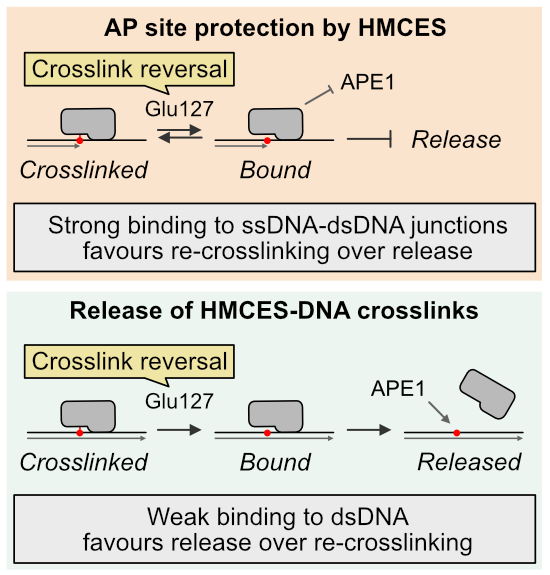DNA repair
Non-proteolytic release of HMCES-DNA-protein crosslinks
31.07.2023
Abstract:
The conserved protein HMCES crosslinks to abasic (AP) sites in ssDNA to prevent strand scission and the formation of toxic dsDNA breaks during replication. Here, we report a non-proteolytic release mechanism for HMCES-DNA-protein crosslinks (DPCs), which is regulated by DNA context. In ssDNA and at ssDNA-dsDNA junctions, HMCES-DPCs are stable, which efficiently protects AP sites against spontaneous incisions or cleavage by APE1 endonuclease. In contrast, HMCES-DPCs are released in dsDNA, allowing APE1 to initiate downstream repair. Mechanistically, we show that release is governed by two components. First, a conserved glutamate residue, within HMCES’ active site, catalyses reversal of the crosslink. Second, affinity to the underlying DNA structure determines whether HMCES re-crosslinks or dissociates. Our study reveals that the protective role of HMCES-DPCs involves their controlled release upon bypass by replication forks, which restricts DPC formation to a necessary minimum.

Figure: Synopsis. The protein HMCES forms covalent crosslinks with abasic sites in ssDNA to prevent the formation of toxic dsDNA breaks. This study reports a non-proteolytic release mechanism that restricts formation of HMCES-DNA crosslinks to a necessary minimum, and that is regulated by DNA context. Source: EMBO Journal 2023
Original Publication:
A non-proteolytic release mechanism for HMCES-DNA-protein crosslinks
Donsbach M, Dürauer S, Grünert F, Nguyen KT, Nigam R, Yaneva D, Weickert W, Bezalel-Buch R, Semlow DR, Stingele J.
EMBO Journal. 2023 Jul 31; https://doi.org/10.15252/embj.2022113360

